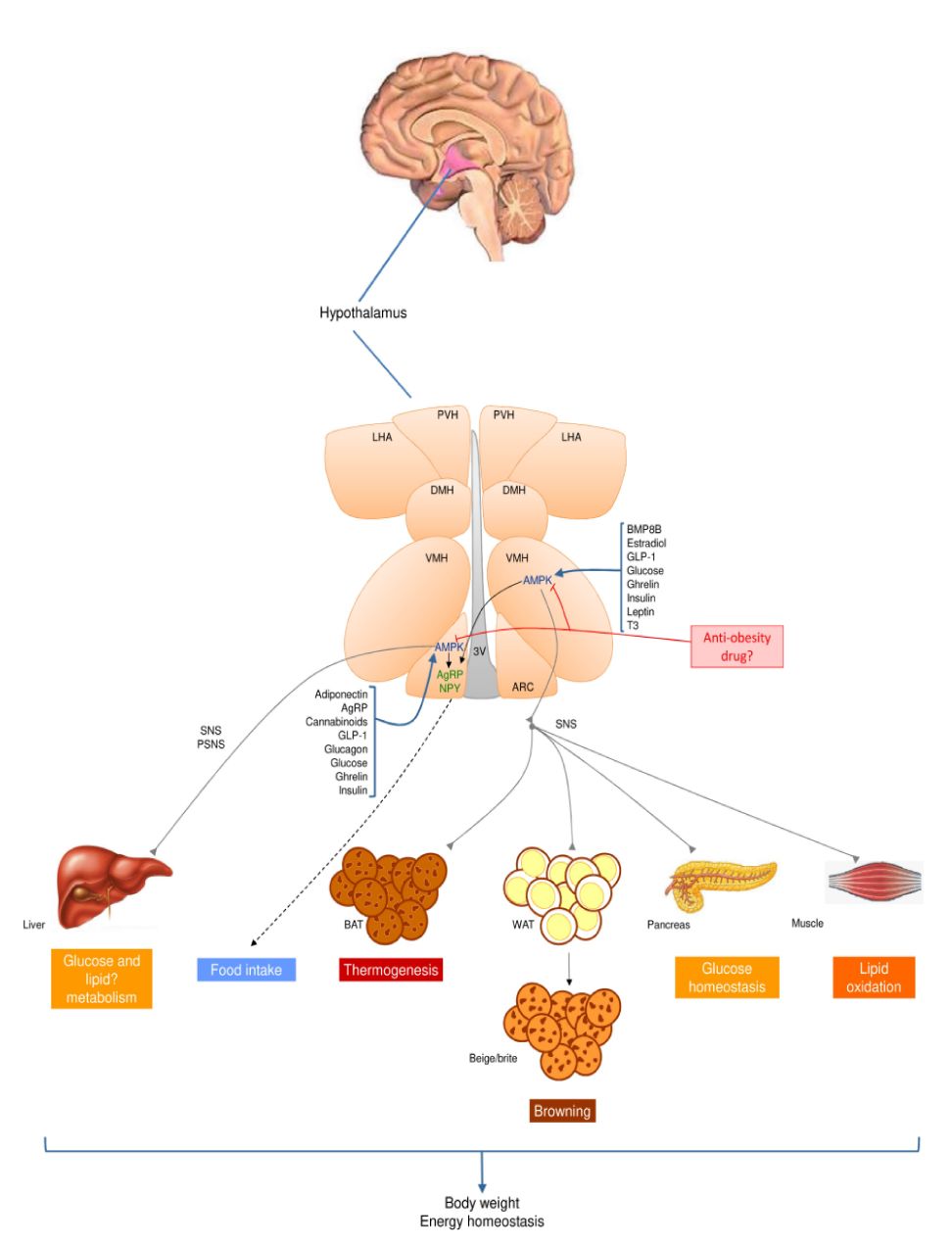AMPK Pathway Phosphorylation Antibody Array
AMP-activated protein kinase (AMPK) is a highly conserved sensor of intracellular adenosine nucleotide levels that is activated when even modest decreases in ATP production result in relative increases in AMP or ADP. AMPK contains a catalytic subunit (a) and two regulatory subunits (β and γ). Under lowered intracellular ATP levels, AMP or ADP can directly bind to the γ regulatory subunits, leading to a conformational change that protects the activating phosphorylation of AMPK. Phosphorylation by AMPK inhibits acetyl-CoA carboxylase (ACC) and results in reduced levels of malonyl-CoA product. AMPK inhibits mTOR signaling pathway by activating Tsc2 and downstream of Tsc2 by inhibiting Raptor component of mTOR complex 1.
 Fig.1 Brain AMPK is a canonical regulator of energy balance.1
Fig.1 Brain AMPK is a canonical regulator of energy balance.1
Due to its roles in fuel regulation, the AMPK pathway is regarded as a potential therapeutic target for diseases, such as diabetes type II, obesity and metabolic syndrome. Here Creative Biolabs offers AMPK signal pathway phosphorylation screening service with antibody array, which consists of 174 high-specific antibodies and more than 70 phosphorylation sites involved in AMPK signal pathways can be tested.
Related Signaling Pathway
| Signal Pathways | |
|
|
Antibody Array Targets
| Targets |
| 4E-BP1 (S65) | CAMK1 (T177) | MEF2A (T319) | RPS6KB1 (S411) |
| 4E-BP1 (T36) | CAMK2 (T305) | MEF2C (S396) | RPS6KB1 (S424) |
| 4E-BP1 (T45) | CAMK2B/CAMK2G/CAMK2D (T287) | MEF2D (S444) | p70S6K (S371) |
| 4E-BP1 (T70) | CaMK4 (T196/T200) | mTOR (S2448) | p70S6K (S418) |
| PFKFB2 (S483) | CAMK2 (T286) | mTOR (S2481) | p70S6K (T229) |
| ACC1 (S79) | CCNB1 (S126) | mTOR (T2446) | p70S6K (T389) |
| ACC1 (S80) | CCNB1 (S147)) | p21Cip1 (T145) | p70S6k (T421) |
| AKT (S473) | EEF2 (T56) | p53 (S15) | p70S6k beta (S423) |
| AKT (T308) | eEF2K (S366) | p53 (S20) | PIK3R1 (Y607) |
| AKT (Y326) | eNOS (S1177) | p53 (S315) | PIK3R1/PIK3R3 (Y467/Y199) |
| AKT1 (S124) | eNOS (S615) | p53 (S33) | PKA CAT (T197) |
| AKT1 (S246) | eNOS (T495) | p53 (S366) | PKA-R2B (S113) |
| AKT1 (T450) | HNF4α (S304) | p53 (S37) | PLC-beta (S1105) |
| AKT1 (T72) | HSF1 (S303) | p53 (S378) | PLCB3 (S537) |
| AKT1 (Y474) | HSL (S552/S563) | p53 (S392) | RapGEF1 (Y504) |
| AKT1S1 (T246) | HSL (S554) | p53 (S46) | SREBP1 (S439) |
| AKT2 (S474) | LKB1 (S428) | p53 (S6) | TSC2 (S939) |
| AMPK1 (T174) | LKB1 (T189) | p53 (S9) | TSC2 (T1462) |
| AMPK1/AMPK2 (S485/S491) | MEF2A (S408) | p53 (T18) | |
| PRKAB1 (S182) | MEF2A (T312) | p53 (T81) |
Protocol Outline
- Extracted protein and biotinylated
- Blocked antibody array
- Incubate with treated protein and control
- Incubate with streptavidin-conjugated fluorophore
- Scan with a microarray laser scanner
- Perform densitometry and analysis
Our Analysis Service
- Suitable for protein, cell and tissue samples from human, mouse and rat
- 6×107 cells or 150 µg protein
- Set replicate spots: treated sample and control
- Results are delivered in 4-5 weeks
For more detailed information about our antibody arrays, please feel free to contact us.
Reference
- López, Miguel. "EJE PRIZE 2017: Hypothalamic AMPK: a golden target against obesity?." European Journal of Endocrinology 176.5 (2017): R235-R246. Distributed under Open Access license CC BY 3.0, without modification.



